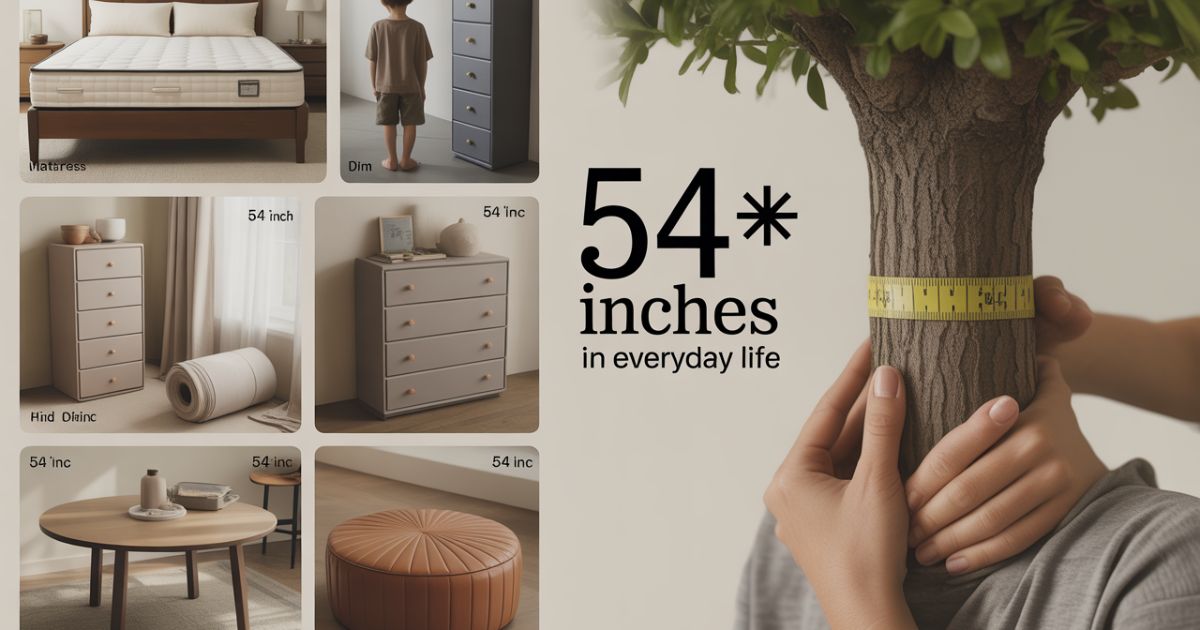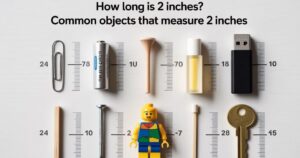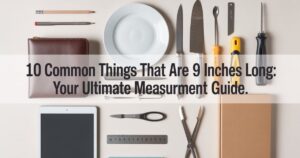Ever found yourself staring at a piece of furniture online, wondering if it’ll actually fit through your doorway? Understanding measurements transforms shopping disasters into success stories. The dimension 54 inches or 4.5 feet, 137.16 centimeters, 1.3716 meters appears more frequently in daily life than you’d imagine.
This specific measurement isn’t random. It represents a sweet spot in manufacturing, design, and human ergonomics. From the average height of a 10-year-old child to the width of your bed, 54 inches shapes how we interact with our surroundings. Let’s explore eight surprising items sharing this exact dimension.
Why Knowing Things That Are 54 Inches Actually Matters
Shopping online has revolutionized convenience. But it’s also created measurement mishaps nobody wants to experience. That gorgeous round dining table? It might overwhelm your breakfast nook. Those window curtains you ordered? They could hang awkwardly short.
Understanding 54-inch dimensions helps you:
- Make confident furniture purchases without guesswork
- Plan room layouts that actually work
- Track your child’s growth milestones meaningfully
- Calculate fabric needs for DIY projects accurately
- Avoid expensive return shipping on oversized items
The imperial to metric conversion becomes second nature once you recognize these everyday reference points. Think of 4 feet 6 inches as roughly 1.37 meters or 1,371.6 millimeters.
1. The Average Height of a 10-Year-Old Child
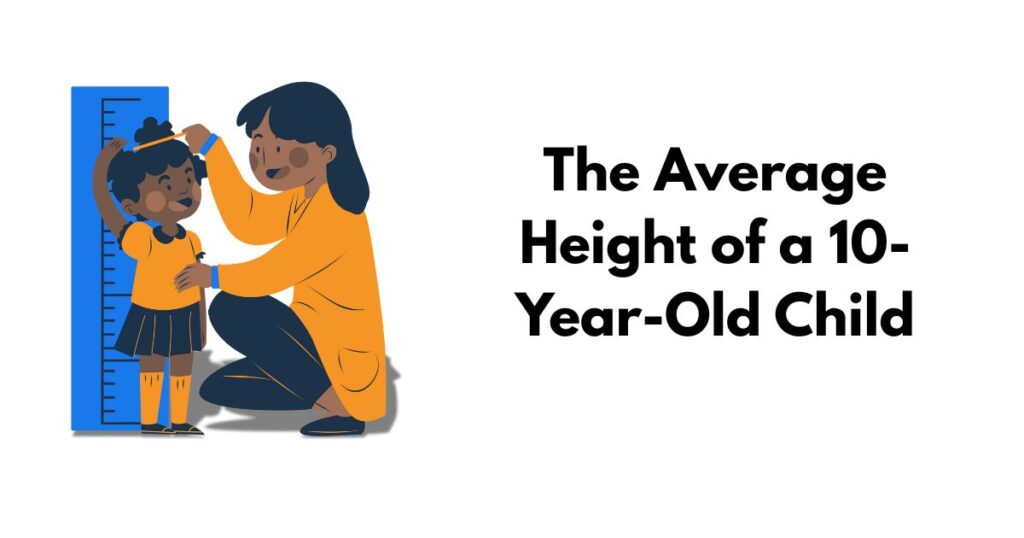
According to Centers for Disease Control and Prevention (CDC) pediatric growth charts, a typical 10-year-old measures approximately 54 inches tall. This represents a significant developmental milestone in pre-teen growth.
Growth Variations by Gender
The child height percentile data reveals interesting patterns:
| Age | Boys (50th Percentile) | Girls (50th Percentile) |
|---|---|---|
| 9 years | 52.5 inches | 52.4 inches |
| 10 years | 54.5 inches | 54.3 inches |
| 11 years | 56.5 inches | 56.7 inches |
| 12 years | 58.6 inches | 59.4 inches |
Girls often reach this height milestone slightly earlier. Genetics, nutrition for bone growth, and regional factors influence these measurements considerably. Children in Northern Europe, for example, tend to track taller than global averages.
Why This Height Matters Practically
At 4.5 feet, children start reaching:
- Standard kitchen countertops (36 inches) comfortably
- Light switches without assistance
- Amusement park ride height requirements (typically 48–54 inches minimum)
- Booster seat height requirements thresholds (most states require boosters until 57 inches)
Parents tracking growth milestones find this measurement reassuring. It signals healthy development and helps determine appropriate clothing sizes for children usually size 10-12 corresponds with this height.
Nutrition plays a crucial role here. Balanced meals rich in calcium, vitamin D, and protein support optimal bone growth during these formative years.
2. The Width of a Full-Size Mattress
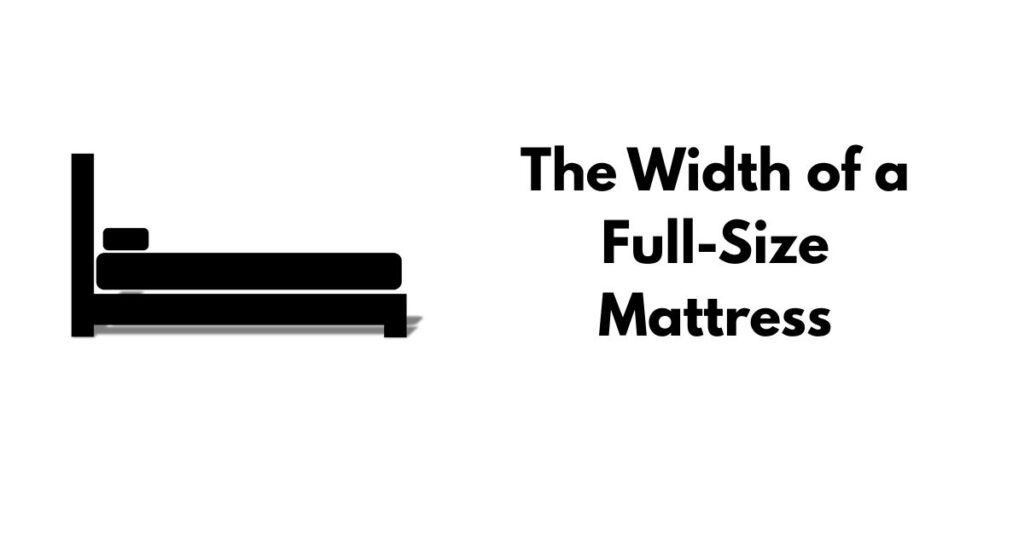
Walk into any mattress store, and you’ll encounter the full-size mattress (also called a double bed). Its width? Exactly 54 inches. The length extends to 75 inches, creating a sleeping surface that’s served families since the early 20th century.
Mattress Sizing Chart Comparison
| Mattress Type | Width | Length | Best For |
|---|---|---|---|
| Twin | 38 inches | 75 inches | Kids, singles |
| Full/Double | 54 inches | 75 inches | Single adults, tight spaces |
| Queen | 60 inches | 80 inches | Couples, standard choice |
| King | 76 inches | 80 inches | Couples wanting space |
| California King | 72 inches | 84 inches | Tall individuals |
Space Planning Reality Check
A full-size mattress width of 4 feet 6 inches requires careful room layout planning. Interior design measurements suggest:
- Minimum bedroom size: 10×12 feet
- Walkway clearance: 24-36 inches on each side
- Room layout optimization considers door swing patterns
This dimension works beautifully for:
- Guest bedrooms with limited square footage
- Single adults who sprawl during sleep
- Teenagers transitioning from twin beds
- Studio apartments maximizing living areas
Couples often find 54 inches a bit snug for comfortable sleep. Each person gets roughly 27 inches narrower than a twin bed. That’s why queen mattress dimensions (60 inches wide) have become America’s most popular choice.
Price ranges vary considerably:
- Budget full mattress: $200-500
- Mid-range options: $500-1,000
- Premium organic latex models: $1,000-2,000
3. The Length of Standard Window Curtains
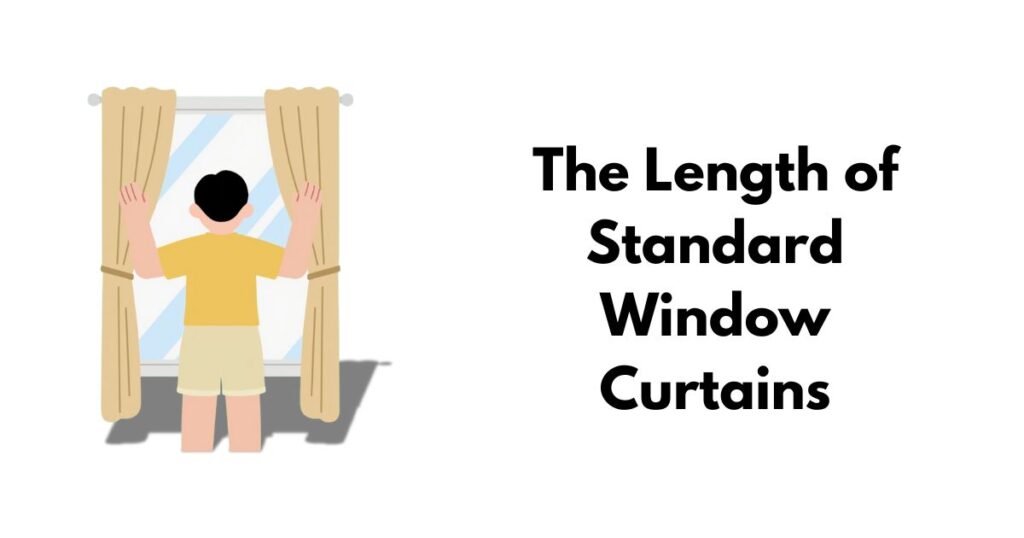
Shopping for window treatment sizes can feel overwhelming. Curtain panels measuring 54 inches long represent one of the most common curtain size tables dimensions available.
Where 54-Inch Curtains Shine
These curtains 54 inches long work perfectly for:
- Kitchen windows above countertops
- Bathroom privacy treatments
- Café-style half windows
- Tier curtains in breakfast nooks
The measurement refers to the fabric length, not including the rod pocket or hanging hardware. Professional designers recommend hanging curtain rods 4–6 inches above the window frame to create visual height.
Material Options Galore
Cotton curtains and polyester blends dominate this size category:
- Cotton: Breathable, natural texture, requires more frequent washing
- Polyester: Wrinkle-resistant, fade-resistant, budget-friendly
- Microfiber fabric: Luxurious drape, blocks light effectively
- Velvet: Heavy, insulating, dramatic appearance
For floor-touch elegance, you’d need 72 inches or longer. The 84–120 inch panels create that designer puddle effect often seen in formal spaces.
DIY Hemming Possibilities
Bought curtains too long? Hemming polyester blends or cotton takes minimal sewing skills. Conversely, lengthening short panels requires adding fabric a trickier proposition entirely.
Sustainable home materials have entered the curtain market recently. Organic cotton and recycled polyester options appeal to environmentally conscious consumers.
4. The Width of Upholstery Fabric

Visit any fabric store, and upholstery fabric width follows industry standardization: 54 inches. This dimension standard emerged during the industrial revolution when textile mills optimized loom widths.
Why This Width Became Standard
Manufacturing efficiency drove this measurement. Standardization in manufacturing meant:
- Consistent bolt widths across suppliers
- Easier fabric yardage calculation for upholsterers
- Reduced waste during furniture production
- Universal pattern sizing in the industry
Compare this to fashion fabric (typically 45 inches) or quilting cotton (usually 42-44 inches). The extra width accommodates furniture dimensions without excessive seaming.
Calculating Your Project Needs
Reupholstering a chair? You’ll need 10–20 yards depending on:
- Furniture size and style
- Pattern repeat requirements (if using prints)
- Cushion complexity and number
- Matching versus contrasting welting choices
DIY projects become more manageable with this width. A sofa cushion measuring 24 inches deep easily cuts from 54-inch fabric without piecing.
Material Durability Matters
Upholstery fabric comes in various compositions:
- Cotton blends: Soft, breathable, moderate durability
- Microfiber: Stain-resistant, pet-friendly, contemporary look
- Faux leather: Easy cleaning, modern aesthetic, animal-friendly
- Polyester: Durable, colorfast, budget-conscious option
The Martindale rub test (measuring fabric abrasion resistance) helps determine appropriateness for high-traffic furniture. Look for ratings above 15,000 rubs for sustainable home materials that last.
5. The Height of a Tall Chest of Drawers

A tall chest of drawers reaching approximately 54 inches high provides substantial storage without consuming excessive floor space. Furniture designers call these highboy dressers a term dating to the 18th century.
Historical Context
The highboy height evolved from Renaissance-era cabinets. Early American furniture makers perfected this proportion during the colonial period. The measurement balances:
- Ergonomics for average adult reach
- Visual proportion with standard 8-foot ceilings
- Storage capacity (typically 5-6 drawers)
Typical Dimensions
| Furniture Type | Height Range | Width | Depth |
|---|---|---|---|
| Tall Chest/Highboy | 50-56 inches | 30-40 inches | 18-24 inches |
| Standard Dresser | 30-35 inches | 50-60 inches | 18-20 inches |
| Lowboy | 30-32 inches | 36-44 inches | 20-22 inches |
| Nightstand | 24-28 inches | 18-24 inches | 16-20 inches |
Safety Considerations Critical
At 4.5 feet, these dressers require anchoring to walls. Tragic tip-over accidents occur when:
- Children climb drawers like ladders
- Multiple drawers open simultaneously shift weight forward
- Top-heavy items (TVs, lamps) add instability
Child ergonomics and safety standards now require furniture anchors with every tall chest purchase. The straps cost mere dollars but prevent devastating injuries.
Style Versatility
Tall chest dimensions suit various aesthetics:
- Modern: Clean lines, minimal hardware, neutral finishes
- Traditional: Ornate pulls, wood grain emphasis, classic stains
- Farmhouse: Distressed finishes, metal bin pulls, rustic charm
Small bedrooms benefit tremendously from vertical storage. A highboy occupies less floor space than wide dressers while offering comparable capacity.
Read This Post: How Tall Is 63 Inches?
6. The Diameter of a Round Dining Table
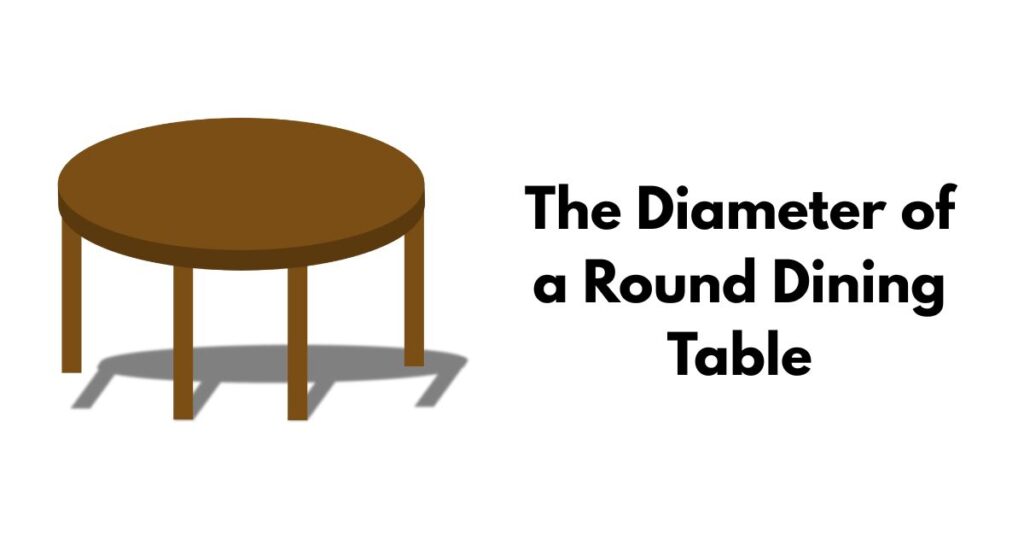
A round dining table diameter of 54 inches creates intimate dining spaces that encourage conversation flow naturally. This home furniture standard seats 4-6 people comfortably.
Space Planning Mathematics
Room layout optimization requires calculating clearances:
- Table diameter: 54 inches
- Chair depth: 18-24 inches
- Walking space: 36 inches minimum
- Total space needed: 126-144 inches (10.5-12 feet) square
A dining room measuring 12×12 feet accommodates this table size perfectly with adequate circulation patterns.
Seating Capacity Details
| Table Diameter | Comfortable Seating | Maximum Squeeze |
|---|---|---|
| 48 inches | 4 people | 5 people |
| 54 inches | 4-6 people | 6-7 people |
| 60 inches | 6-8 people | 8-9 people |
| 72 inches | 8-10 people | 10-12 people |
Each diner needs approximately 24 inches of table edge for comfortable elbow room. A 54-inch circumference (roughly 170 inches around) divides nicely for six adults.
Why Round Tables Work
Compared to rectangular tables:
- Sight lines remain unobstructed for all diners
- No “head of table” hierarchy exists
- Traffic flow improves in tight spaces
- Corners won’t bruise shins or hips
Seating arrangements feel more democratic and conversational. Families with young children appreciate the absence of sharp corners entirely.
Pedestal vs. Four-Leg Bases
Pedestal bases maximize leg room underneath. Four-leg designs offer traditional stability but can interfere with chair placement. The choice affects both aesthetics and functionality significantly.
7. The Length of a Faux Leather Ottoman

Storage ottomans measuring 54 inches long serve multiple functions brilliantly. These versatile pieces work as coffee tables, extra storage solutions, and occasional seating simultaneously.
Ottoman Dimension Standards
Typical ottoman proportions include:
- Length: 48-60 inches (54 inches hits the sweet spot)
- Width: 20-30 inches
- Height: 16-18 inches
The 54-inch length pairs beautifully with sectional sofas or standard three-seat couches. Interior design dimensions suggest leaving 18 inches between sofa and ottoman for comfortable leg extension.
Faux Leather Benefits
Faux leather has evolved tremendously from early vinyl versions:
- Durability: Resists scratches better than genuine leather
- Maintenance: Wipes clean easily with damp cloths
- Ethics: No animal products involved in production
- Cost: Significantly cheaper than authentic leather
- Variety: Available in countless colors and textures
Modern microfiber fabric treatments create surprisingly realistic leather looks. Some higher-end options rival genuine leather’s appearance and feel.
Hidden Storage Capacity
Lift-top ottomans at this size hold:
- Throw blankets and extra pillows
- Kids’ toys for quick cleanup
- Board games and entertainment items
- Seasonal décor between holidays
- Magazines and remote controls
The storage optimization benefits small living spaces especially. Everything stays accessible yet hidden from view completely.
Style Coordination Tips
Match your faux leather ottoman to:
- Modern spaces: Sleek lines, neutral tones, metal legs
- Traditional rooms: Button tufting, rich browns, wood bases
- Eclectic designs: Bold colors, patterned fabrics, unexpected shapes
Price ranges span widely:
- Budget options: $100-200
- Mid-range quality: $200-300
- Premium construction: $300-400+
8. The Height for Measuring Tree Diameter (DBH)
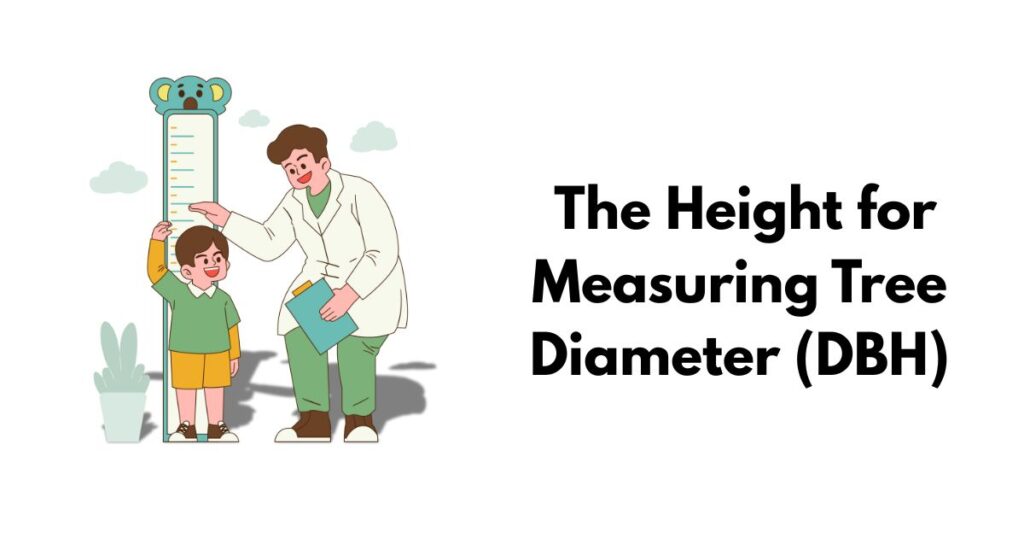
Foresters worldwide measure trees at diameter at breast height (DBH) standardized at 4.5 feet or 54 inches above ground level. This forestry standard enables consistent data collection across species and regions.
Why This Specific Height?
The measurement emerged from practical considerations:
- Average adult chest height for comfortable measuring
- Above root flare irregularities
- Below most branch emergence points
- Standardization allows global data comparison
Environmental conservation efforts rely heavily on DBH measurements. Tree volume, carbon sequestration capacity, and age estimation all derive from this single data point.
Measurement Technique
Professional timber volume calculation follows these steps:
- Stand on the tree’s uphill side
- Measure 4.5 feet vertically from ground
- Wrap diameter tape around trunk perpendicular to axis
- Record measurement in inches or centimeters
- Note any irregularities affecting accuracy
Diameter tapes eliminate mathematical conversions. They read circumference but display diameter directly a clever tool design.
What DBH Reveals
A tree’s diameter at 54 inches indicates:
- Young pine: 6-12 inches DBH (20-40 years old)
- Mature oak: 24-36 inches DBH (100-150 years old)
- Ancient redwood: 60+ inches DBH (500-1,000+ years old)
Growth rates vary dramatically by species, climate, and soil conditions. Forestry standards account for these variables when estimating age.
Practical Applications
Arborists use DBH for:
- Tree health assessment and monitoring
- Determining removal costs and complexity
- Calculating property values for real estate
- Planning harvest schedules in managed forests
- Tracking climate change impacts on growth rates
Homeowners curious about their yard trees can measure DBH easily. It provides fascinating insights into your property’s living history.
How to Visualize 54 Inches in Your Daily Life
Measurement conversions become intuitive with practice. Here are tricks for estimating 54 inches without tools:
Body-Based References
- Most adults: measure from floor to mid-chest roughly
- Your arm span: divide by 1.3-1.4 approximates height
- Two standard doors stacked? Too tall by several inches
Household Item Comparisons
- Full mattress lying on its side (width becomes height)
- Five and a half standard bricks lengthwise
- One and a half yard sticks end-to-end
Digital Tools Available
Smartphone apps using augmented reality measure surprisingly accurately now. Apple’s Measure app and Google’s AR tools work well for quick reference measurements.
FAQ’s
How many feet is 54 inches exactly?
Exactly 4.5 feet or 4 feet 6 inches. Divide any inch measurement by 12 to convert to feet. This equals 1.5 yards, 137.16 centimeters, or 1.3716 meters in metric units.
What common household items measure 54 inches?
The width of full-size mattresses, height of tall chest drawers, diameter of certain round dining tables, length of storage ottomans, and standard window curtain lengths all frequently measure 54 inches.
Is 54 inches considered tall for a child?
This represents the average height for 10-year-olds according to CDC growth data. It falls in the 50th percentile perfectly normal development. Children reach this milestone between ages 9-11 typically.
How do I measure 54 inches without a tape measure?
Use your body as reference. Most adults can approximate 4.5 feet from floor to mid-chest. Stack common items like books (roughly 9 inches tall means six books), or use smartphone measurement apps for accuracy.
What’s 54 inches in centimeters?
137.16 centimeters precisely, or approximately 1.37 meters. This converts to 1,371.6 millimeters or 0.00137 kilometers. The metric to imperial conversion multiplies inches by 2.54.
Can a 54-inch measurement help with furniture shopping?
Absolutely. Knowing this dimension helps you evaluate full mattress sizing, assess curtain lengths for windows, calculate upholstery fabric needs, and determine if round tables fit your dining space appropriately.
Conclusion
The 54-inch measurement whether expressed as 4.5 feet, 137 centimeters, or 1.37 meters appears constantly in daily life. From tracking your child’s growth milestones using pediatric growth charts to selecting the perfect full-size mattress width for your guest room, this dimension matters practically.
Understanding these common reference points transforms shopping from guesswork into confident decision-making. You’ll evaluate furniture dimensions, calculate fabric yardage, and plan room layouts with newfound precision. The ancient Roman measurements and standardization in manufacturing created dimensions that still serve us centuries later.
Next time you’re measuring anything around your home, notice how frequently 54 inches appears. That tall chest in your bedroom? The upholstery fabric on your sofa? The height where foresters measure trees? They’re all connected by this surprisingly ubiquitous dimension. Start recognizing these measurements today your spatial awareness will improve dramatically.

Ethan is the expert voice behind Sizefinders.com, helping readers understand measurements with ease. He simplifies complex sizing guides into clear, practical tips anyone can use. With a passion for accuracy, Ethan makes finding the right fit simple and stress-free.
